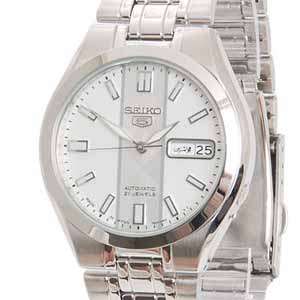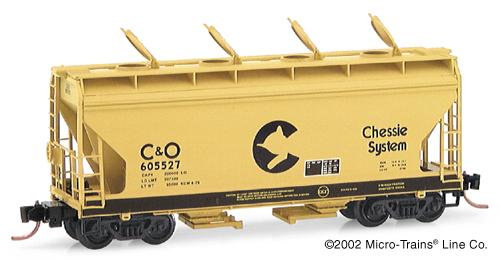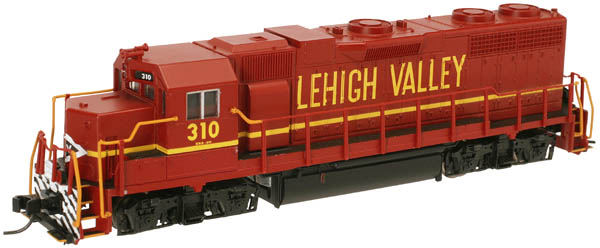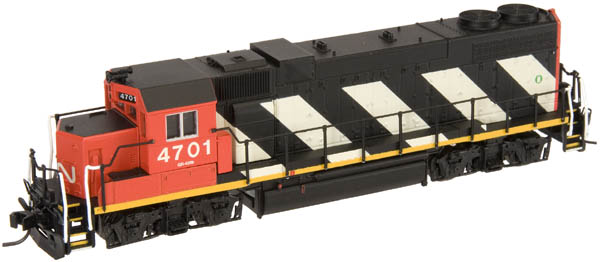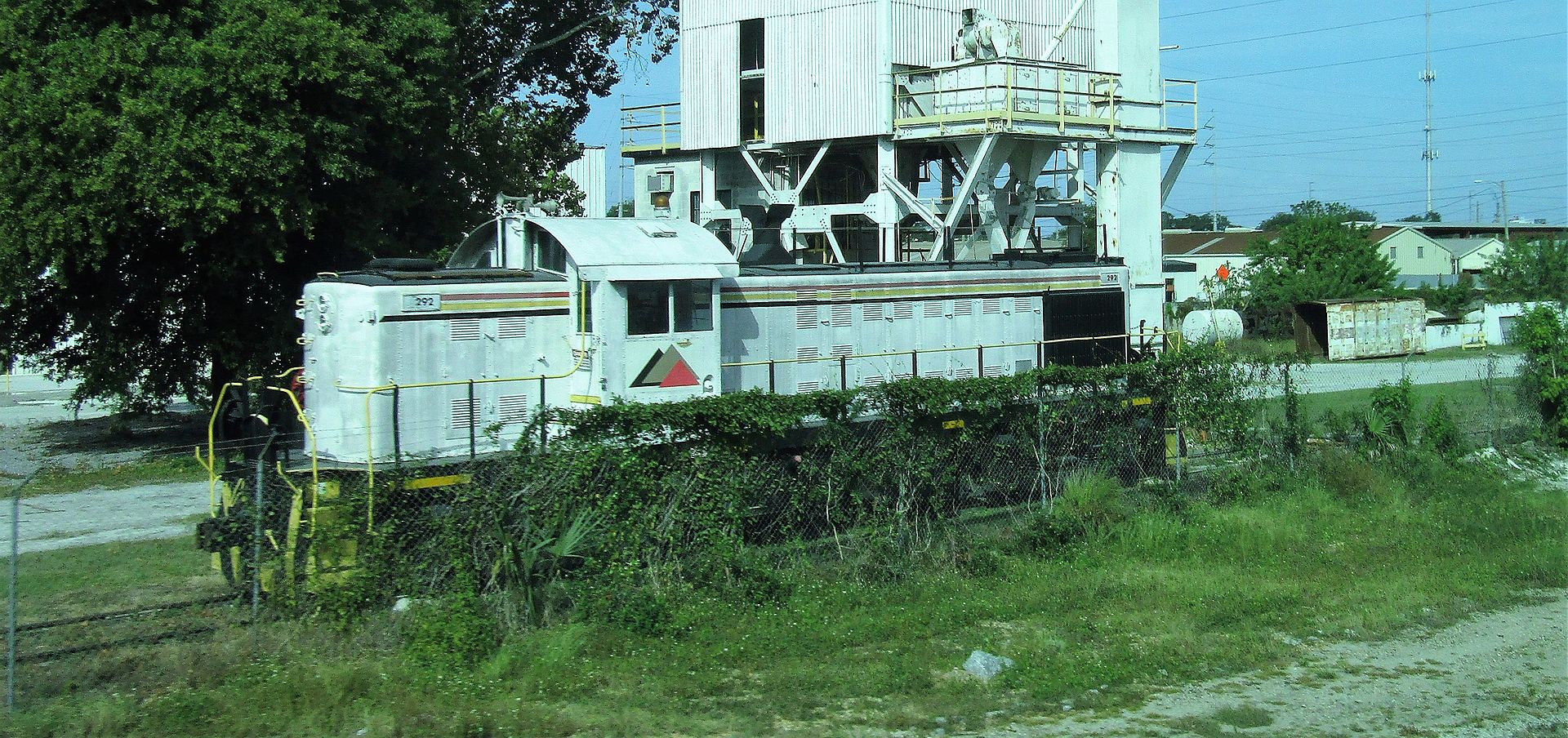Model Information: Atlas introduced this model in 1988. From 1988 - 1997 this model was produced for Atlas by Kato Japan. In 1998, a new version was designed by Atlas and production was moved to China.
Both versions feature a split-frame design with flywheels. They run smoothly and quietly, but despite the split frame they use a two-part lightboard. In my opinion they should have upgraded to a single-piece lightboard when they did the retooling in 1998 or better yet, introduced a NEM 651 socket. The detail on the shell is typical high quality Kato/Atlas work and the printing is crisp and accurate.
Both versions feature a split-frame design with flywheels. They run smoothly and quietly, but despite the split frame they use a two-part lightboard. In my opinion they should have upgraded to a single-piece lightboard when they did the retooling in 1998 or better yet, introduced a NEM 651 socket. The detail on the shell is typical high quality Kato/Atlas work and the printing is crisp and accurate.
DCC Information: These locomotives qualify as DCC-Friendly because even a relatively solder-clumsy idiot like myself can successfully install a TCS CN-Series decoder into one of these. It was a lot more work than a drop-in decoder, but there are lots of good internet resources explaining how to complete this. I was able to work off the well-written instructions included with the engine, but it was difficult enough, I have been hesitant to install anymore. Furthermore, the CN-Series decoders are a bit pricier than the simpler one-piece "drop-in" decoders most of us are familiar with. One note I would like to make is that the engine was much noisier with the decoder installed than it was when in DC mode. I suspect this was do to my sloppy installation technique, but I had been fairly careful and when I disassembled it to find the sources of the noise, I was baffled.
In summary, a nice engine for DC operations. If you want a DCC version, you can upgrade it yourself with some trouble or hire a pro to do it for you.
In summary, a nice engine for DC operations. If you want a DCC version, you can upgrade it yourself with some trouble or hire a pro to do it for you.
Prototype History: The ALCO RS-1 was a 4-axle diesel-electric locomotive built by Alco-GE between 1941 and 1953 and the American Locomotive Company from 1953 to 1960. The Montreal Locomotive Works built three RS-1s in 1954. This model has the distinction of having the longest production run of any diesel locomotive for the North American market. The RS-1 was in production for 19 years from the first unit Rock Island #748 in March 1941 to the last unit National of Mexico #5663 in March 1960.
The hood unit configuration of the RS-1 pioneered the road switcher type of diesel locomotive, beginning the move away from the carbody units which were the standard design for road diesel locomotives before then. Most North American locomotives built since have followed this basic design. In 1940, the Rock Island Railroad approached ALCO about building a locomotive for both road and switching service.
The first thirteen production locomotives were requisitioned by the US Army, the five railroads affected had to wait while replacements were manufactured. The requisitioned RS-1s were remanufactured by ALCO into six axle RSD-1s for use on the Trans Iranian Railroad to supply the Soviet Union during World War Two.
From Wikipedia
The hood unit configuration of the RS-1 pioneered the road switcher type of diesel locomotive, beginning the move away from the carbody units which were the standard design for road diesel locomotives before then. Most North American locomotives built since have followed this basic design. In 1940, the Rock Island Railroad approached ALCO about building a locomotive for both road and switching service.
The first thirteen production locomotives were requisitioned by the US Army, the five railroads affected had to wait while replacements were manufactured. The requisitioned RS-1s were remanufactured by ALCO into six axle RSD-1s for use on the Trans Iranian Railroad to supply the Soviet Union during World War Two.
From Wikipedia
Road Name History: 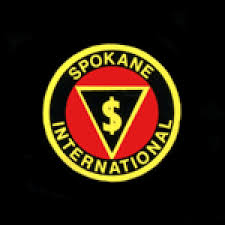 The Spokane International Railroad (reporting mark SI) was a short line railroad between Spokane, Washington, and the Canadian Pacific Railway (CP) at Kingsgate, British Columbia. The line became an important one for the CP with its connections to the Union Pacific Railroad and Portland, Oregon.
The Spokane International Railroad (reporting mark SI) was a short line railroad between Spokane, Washington, and the Canadian Pacific Railway (CP) at Kingsgate, British Columbia. The line became an important one for the CP with its connections to the Union Pacific Railroad and Portland, Oregon.
The line, originally named the Spokane International Railway, was built by local businessman and railroader Daniel Chase Corbin following an agreement between him and the CP, with CP agreeing to fund much of the line's construction and to secure the loan by holding the new line's bonds.
Especially significant was that the CP controlled the Minneapolis, St. Paul and Sault Ste. Marie Railway (Soo Line) and its connections to Minneapolis, Minnesota, Saint Paul, Minnesota, and Chicago, Illinois. Completion of the Spokane International now meant that the CP could compete with the Northern Pacific Railway and Great Northern Railway lines for transportation between the Midwest and the Puget Sound area (in conjunction with the Union Pacific Railroad subsidiary Oregon-Washington Railroad and Navigation Company west of Spokane). Express passenger service was soon introduced on the line via the Soo-Spokane Train De Luxe.
The SI was reorganized October 1, 1941, following financial difficulties and receivership during the Great Depression. The line was renamed the Spokane International Railroad as part of the restructuring agreement until the 1950s.
On October 6, 1958, the Union Pacific Railroad (UP) took control of Spokane International Railroad. In 1962 UP leased SI's 11 ALCO RS-1 locomotives for operation. The locomotives were later repainted to UP's yellow and gray paint scheme, but retained their SI lettering. Also in 1962, UP sold four of its older steel cabooses to SI. These were also painted in UP's yellow scheme, but received SI lettering and numbers. After UP's 1958 control of SI, Union Pacific continued to lease SI for operation. On December 31, 1987, Union Pacific formally merged SI into its corporate structure.
At the end of 1960 SI operated 150 miles of road on 190 miles of track; that year it reported 141 million net ton-miles of revenue freight and zero passengers.
The line remains in operation as an important UP connection between southern British Columbia and the northwest United States.

The line, originally named the Spokane International Railway, was built by local businessman and railroader Daniel Chase Corbin following an agreement between him and the CP, with CP agreeing to fund much of the line's construction and to secure the loan by holding the new line's bonds.
Especially significant was that the CP controlled the Minneapolis, St. Paul and Sault Ste. Marie Railway (Soo Line) and its connections to Minneapolis, Minnesota, Saint Paul, Minnesota, and Chicago, Illinois. Completion of the Spokane International now meant that the CP could compete with the Northern Pacific Railway and Great Northern Railway lines for transportation between the Midwest and the Puget Sound area (in conjunction with the Union Pacific Railroad subsidiary Oregon-Washington Railroad and Navigation Company west of Spokane). Express passenger service was soon introduced on the line via the Soo-Spokane Train De Luxe.
The SI was reorganized October 1, 1941, following financial difficulties and receivership during the Great Depression. The line was renamed the Spokane International Railroad as part of the restructuring agreement until the 1950s.
On October 6, 1958, the Union Pacific Railroad (UP) took control of Spokane International Railroad. In 1962 UP leased SI's 11 ALCO RS-1 locomotives for operation. The locomotives were later repainted to UP's yellow and gray paint scheme, but retained their SI lettering. Also in 1962, UP sold four of its older steel cabooses to SI. These were also painted in UP's yellow scheme, but received SI lettering and numbers. After UP's 1958 control of SI, Union Pacific continued to lease SI for operation. On December 31, 1987, Union Pacific formally merged SI into its corporate structure.
At the end of 1960 SI operated 150 miles of road on 190 miles of track; that year it reported 141 million net ton-miles of revenue freight and zero passengers.
The line remains in operation as an important UP connection between southern British Columbia and the northwest United States.
Brand/Importer Information: In 1924 Stephan Schaffan, Sr. founded the Atlas Tool Company in Newark, New Jersey. In 1933 his son, Stephan Schaffan, Jr., came to work for his father at the age of sixteen. Steve Jr. built model airplanes as a hobby and frequented a local hobby shop. Being an enterprising young man, he would often ask the owner if there was anything he could do to earn some extra spending money. Tired of listening to his requests, the hobby-store owner threw some model railroad track parts his way and said, "Here, see if you can improve on this".
In those days, railroad modelers had to assemble and build everything from scratch. Steve Jr. created a "switch kit" which sold so well, that the entire family worked on them in the basement at night, while doing business as usual in the machine shop during the day.
Subsequently, Steve Jr. engineered the stapling of rail to fiber track, along with inventing the first practical rail joiner and pre-assembled turnouts and flexible track. All of these products, and more, helped to popularize model railroading and assisted in the creation of a mass-market hobby. The budding entrepreneur quickly outgrew the limitations of a basement and small garage operation. Realizing they could actually make a living selling track and related products, Steve and his father had the first factory built in Hillside, New Jersey at 413 Florence Avenue in 1947. On September 30, 1949, the Atlas Tool Company was officially incorporated as a New Jersey company.
In 1985, Steve was honored posthumously for his inventions by the Model Railroad Industry Association and was inducted into the Model Railroad Industry Hall of Fame in Baltimore, Maryland. In addition, Steve was nominated and entered into the National Model Railroad Association Pioneers of Model Railroading in 1995.
In the early 1990s, the Atlas Tool Company changed its name to Atlas Model Railroad Company, Inc.
In those days, railroad modelers had to assemble and build everything from scratch. Steve Jr. created a "switch kit" which sold so well, that the entire family worked on them in the basement at night, while doing business as usual in the machine shop during the day.
Subsequently, Steve Jr. engineered the stapling of rail to fiber track, along with inventing the first practical rail joiner and pre-assembled turnouts and flexible track. All of these products, and more, helped to popularize model railroading and assisted in the creation of a mass-market hobby. The budding entrepreneur quickly outgrew the limitations of a basement and small garage operation. Realizing they could actually make a living selling track and related products, Steve and his father had the first factory built in Hillside, New Jersey at 413 Florence Avenue in 1947. On September 30, 1949, the Atlas Tool Company was officially incorporated as a New Jersey company.
In 1985, Steve was honored posthumously for his inventions by the Model Railroad Industry Association and was inducted into the Model Railroad Industry Hall of Fame in Baltimore, Maryland. In addition, Steve was nominated and entered into the National Model Railroad Association Pioneers of Model Railroading in 1995.
In the early 1990s, the Atlas Tool Company changed its name to Atlas Model Railroad Company, Inc.
Item created by: gdm on 2016-01-04 15:05:22. Last edited by Lethe on 2020-05-07 00:00:00
If you see errors or missing data in this entry, please feel free to log in and edit it. Anyone with a Gmail account can log in instantly.
If you see errors or missing data in this entry, please feel free to log in and edit it. Anyone with a Gmail account can log in instantly.





